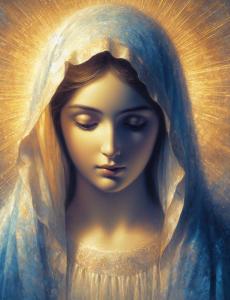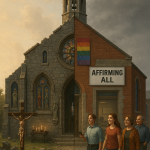Guest contributor: Matt Graham
I want to thank Dennis Knapp for asking me to engage with him on this important topic. To kick things off, I would like to start by pointing out those things upon which we agree. This is helpful for friendly dialogue and for avoiding misunderstanding regarding where the disagreement really lies.
Where we agree:
- Those who have distinguished themselves in their love and service to God or have been chosen by God for a special purpose ought to be highly regarded.
- There is a real difference between having a profound respect/reverence for someone and worshipping someone. The former is ok, the latter is not.
- Mary is the Mother of God and is blessed.
- The distinction between latria, dulia, and hyperdulia is legitimate and meaningful.
Some Protestant critics of the practice of veneration and prayer to saints find themselves saying, “Well technically the distinctions between latria, dulia, and hyperdulia are good distinctions. The problem is that in practice people seem to be worshipping (latria) these created beings, and that is idolatry”.
However, this is to admit that the Catholic Church is, in principle, correct. If some parishioners aren’t practicing Catholicism correctly, that is not a refutation of Catholic doctrine. It would merely show that people can misunderstand Catholic doctrine. The corrective, in this case, would be to teach people how to properly venerate and pray to saints. I think the problem is deeper than that.
My concern with these doctrines is not primarily about their possible abuses. My concern is that the act itself may be a form of institutionalized idolatry. Catholics think they are venerating and or praying to special humans who were canonized and now assist us in our walk with God. Saints do this by example and by presenting our prayers to God in a way that is superior to bringing our own needs to God directly.
I am concerned that Catholics are wrong about this. Instead of praying to saints and angels, I worry that they are (in fact) following practices that were problematic accretions that became established Catholic teaching and practice. This is a massive claim! I don’t pretend that I can adequately defend this claim. I will toss out some reasons for my claim over the next several replies to Dennis and see where this proposal goes.
Praying To Saints
In this article, I want to focus on prayer to the saints. I have two points regarding this issue:
- Scripture does not set a clear precedent for a normative doctrine or practice of praying to saints.
- I am concerned that these doctrines and practices are refined versions of some earlier anti-Christian doctrines and practices.
Point 1
Lutheran academic Jordan Cooper claims that there is no precedent in Scripture for some normative practice of praying to saints. The Bible is full of examples of people praying to God, but we have only a handful of possible counterexamples. As Dennis already alluded to earlier, Revelation 5:8 may be the strongest example. However, it would be a stretch to say that it establishes a normative practice of praying to saints.
What we see in Scripture then is an abundant precedent for praying to God and a relative silence regarding the establishment of prayer to the saints. That silence largely continued until the 2nd century when Irenaeus of Lyon (Against Heresies Book II Chapter 32 Paragraph 5) denounced the practice of “angelic invocations” and “incantations”. He associates these practices with the heretical sect known as the Gnostics.
Nor does [the church] perform anything by means of angelic invocations, or by incantations, or by any other wicked curious art; but, directing her prayers to the Lord, who made all things, in a pure, sincere, and straightforward spirit, and calling upon the name of our Lord Jesus Christ, she has been accustomed to work miracles for the advantage of mankind, and not to lead them into error.
Catholics reading this will likely take immediate offense to any sort of parallel drawn between the gnostic practice of angel worship and the Catholic doctrines regarding prayers to the saints. And rightfully so. I have not established a connection between them. So far, I have only pointed out that there doesn’t seem to be a positive case from the Old and New Testament for a normative practice. In addition to that, I have pointed out that if one is looking for talk of prayer or invocations to beings other than God, Irenaeus seems to be one of the earliest post-New Testament examples of this.
This leads me to point 2. Are there reasons for thinking that the practice of praying to saints is a kind of refined version of earlier neo-platonic and or gnostic anti-Christian doctrines?
Point 2
The doctrine, however, of Simon’s sorcery, which inculcated the worship of angels, was itself actually reckoned amongst idolatries and condemned by the Apostle Peter in Simon’s own person.
-Tertullian’s The Prescription Against Heretics, Chapter 34
As I see it, the primary concern with prayer to saints and angels is that it may be a form of idolatry. If it is, then it is not an acceptable practice. If Catholics were saying that we need to worship the saints, then we could close the book on the matter. Their doctrine and practice would be wrong. Since that is not what Catholics say, the Protestant needs to give some sort of reason for thinking that Catholics are committing idolatry.
As Dennis mentioned, Catholics claim they are asking the saints to pray for us. This act is often compared to asking another member of your church to pray for you. And who would think that asking another church member to pray for you is problematic? Surely comparing this practice to anything like early gnostic doctrines is absurd, right?
It is well known that gnostic and Neoplatonist groups played a pivotal role in the culture during the formation of the church. These groups differed among themselves, and they differed from Catholic Christianity. Christianity couldn’t help but take some influence from these groups, especially the Neoplatonists. This can be seen in the councils themselves as they leverage Greek thought (including words that were used in gnostic circles) in their formulation. Augustine was influenced by Neoplatonism and he influenced Western civilization.
I am not qualified to sort out the tangled web of interplaying beliefs. And yet if I am to have a defensible position on this issue, I have to undertake the comical attempt to do just that. By the end of our back and forth, you will not have any sort of definitive answer. All I can do is attempt, as a decently read layperson, to sort this out.
I will start with this:
Since I don’t see prayer to saints and angels being taught as some sort of normative practice in the Old or New Testament, and since I don’t see it clearly taught in the first few centuries of the church, and since one of the earliest mentions of a similar sounding practice is denounced as a gnostic (un-Christian) practice, I think it is legitimate to ask if there were other potential sources for the practice of praying to saints.
We know that the worship of angels was condemned among Christians, but it was practiced among the Gnostics. Additionally, their cosmology was a tiered system where their god “The One” was incomprehensible, immeasurable, eternal, pure perfection, etc. and there existed a descending divine hierarchy of aeons with Barbelo at the top of this hierarchy.
Barbelo, this “initial power” is a feminine aeon, closest to the father. She is portrayed as the divine mother. The Apocryphon of John describes her this way:
She is the initial power
glory of Barbelo
glorious among the realms
glory of revelation
She gave glory to the Virgin Spirit
She praised Him
For she arose from Him.
[This, the first Thought, is the Spirit’s image] She is the universal womb
She is before everything
Am I claiming that the Catholic view of Mary is directly derived from Barbelo? No. Barbelo is but one example of a high view of a feminine character during the time of the formation of the church. There are many differences between the Catholic view of Mary and the gnostic figure of Barbelo. But if I am asking, how did Mary end up so high on the hierarchy of being in Catholic cosmology, I am inclined to think that there was some influence here. And this is because I don’t see this exalted view of Mary in the Scriptures themselves. If Mary is who Catholics say she is, then testimony to this view is woefully absent in the New Testament.
So exalted is the view of Mary and the saints that the Catechism of the Catholic Church claims that improper use of the names of God, Jesus, the Virgin Mary, and the saints amounts to blasphemy.
2146 “The second commandment forbids the abuse of God’s name, i.e., every improper use of the names of God, Jesus Christ, but also of the Virgin Mary and all the saints.”
I would not get this exalted view of Mary from the Scriptures. It is so exalted that I would expect her to be discussed more in the New Testament and early Christian writings. Granted, I can’t say it’s false because we don’t hear more about her – it’s just that given her importance, I would expect very early testimony of her exalted position.
I have run out of words for this response. More to come in my next reply.
Thank you!
Read The Latin Right’s other writing here.
Please visit my Facebook page and IM your questions (and follow my page) or topics for articles you would like covered.
Also, please subscribe my YouTube page for updates on upcoming articles.













